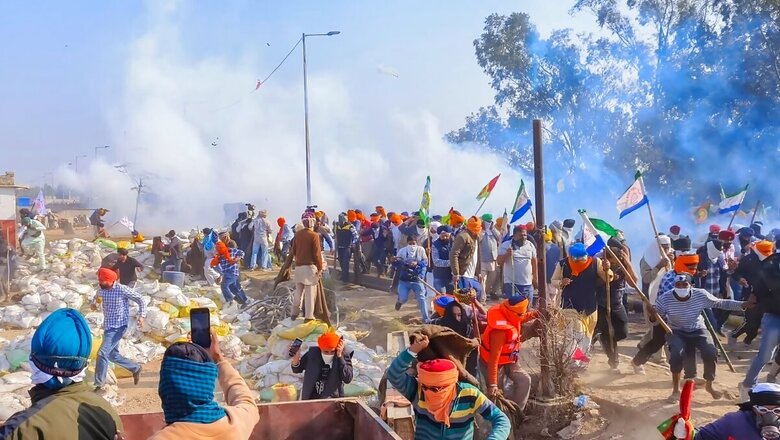
views
The farmers are staging a comeback with ‘Delhi Chalo 2.0’, aiming for the stars in their demands from the government. Despite the government consistently increasing the Minimum Support Price (MSP) for the 22 crops, these farmers want more, seemingly unaware of the ongoing increments. Hold on tight, there’s a hefty wishlist! They are after a complete debt waiver, a monthly pension for farmers above 60, and a throwback to the Land Acquisition Act of 2013. It’s like asking for a windfall while overlooking the financial reality.
And it doesn’t stop there – they’re suggesting axing all current free trade agreements and bidding farewell to the World Trade Organisation (WTO). Because who needs global collaboration when you can slam the door on progress?
In this ironic farmyard tale, we will delve into the amusing intricacies of why these demands might be a bit too much. From pushing for a law to guarantee MSP, despite consistent increases, to proposing a complete withdrawal from the WTO and scrapping existing FTAs – these farmers seem to be on a quest for demands that defy both logic and economic sense. Welcome to “Farmers Protest 2.0: Demanding the Unattainable”, where the sequel might leave you scratching your head more than applauding.
In the ongoing series of negotiations between the Central government and farmers’ unions, the fourth round took place in Chandigarh on Sunday night. Amidst the persistent ‘Delhi Chalo’ march and the pressing demands for unmet promises, farmers decided to momentarily halt their march after the meeting. The saga continues, with each meeting feeling like a chapter in a story with an uncertain ending.
Now, let’s delve into the government’s proposals:
- Long-Term Crop Commitment: The Central government presented a five-year plan for the procurement of pulses, maize, and cotton crops through government agencies at minimum support prices. A strategic move to provide stability in an otherwise tumultuous agricultural landscape.
- Structured Agricultural Contracts: Piyush Goyal outlined a cooperative approach. The NCCF and NAFED will enter into contracts with farmers cultivating tur dal, urad dal, masoor dal, or maize, assuring them a minimum support price for their produce over the next five years. It’s a serious attempt at bringing structure to the uncertainty looming over agricultural incomes.
This meeting, the fourth in the series held on February 8, 12, and 15, aims to find common ground amid the complexities of the farmers’ demands and the government’s policy proposals. Amidst the sealed borders, fuming farmers, chaotic rallies, attacking journalists, disruptions, and traffic jams courtesy of the so-called farm protests, one might wonder: is this a genuine outcry or just a well-timed theatrical performance aimed at garnering social media buzz before the Lok Sabha elections? The farmers leading the charge hail from the politically crucial states of Punjab, Haryana, and Uttar Pradesh – a strategic move given their significance in the Hindi heartland.
Could it be that these protests are more about creating hashtags than addressing agricultural concerns? The opposition INDIA bloc, sensing its last chance to make a splash before the 97 crore voters hit the polls in the upcoming Lok Sabha elections, might just be orchestrating a political symphony disguised as a farmers’ protest.
Facing an existential crisis with exits from the Nitish Kumar-led JD(U) and the RLD, the INDI alliance is also dealing with partners like Mamata Banerjee and Arvind Kejriwal declaring their solo election plans. Now, the pieces of the puzzle seem to fall into place – it’s not just about crop prices and farm laws, it’s about political survival and manoeuvring. Is this their response to ‘Abki Baar, 400 Paar’? Well, time will tell.
Let’s go back to a time when the experts thought the Bharatiya Janata Party (BJP) was in trouble in Rajasthan and just hanging on in Madhya Pradesh. Rajasthan’s voters were pretty fed up with the ruling party for 20 years, but this time, farmers took centre stage, making their voices heard through votes.
Fast forward to the 2019 Lok Sabha elections, and despite worries about farmers’ problems, the BJP pulled off a political magic trick in the Hindi heartland, winning over farm voters. Turns out, the political fortune tellers didn’t see that coming. The 2019 Lok Sabha elections saw similar patterns. A June 2019 brief published by the Institute of South Asian Studies of the National University of Singapore, concluded that “despite distress in the farming community”, the BJP successfully manoeuvred to get the support of farm voters across the Hindi heartland, defying all its doomsayers.
But let’s not sugarcoat things – farmers outside Punjab are struggling. On average, an Indian farming household earns a modest Rs 10,218 per month. Now, Punjab is a bit of an outlier, with an income exceeding Rs 26,000 – the highest among big farming states. In the agrarian landscape of Punjab, farmers enjoy a significant advantage – they receive a Minimum Support Price (MSP) exceeding Rs 60,000 crore annually. This generous support is set at about 50 per cent more than the weighted average cost of production, aligning with MS Swaminathan’s C2+50 per cent formula. The special treatment doesn’t end there – the Centre not only pays promptly but also lifts all the wheat and paddy the farmer wants to sell.
However, it’s crucial to note that this C2+50 price and open-ended procurement are exclusive to wheat and paddy, making it a privilege reserved for Punjab and, to some extent, Haryana. In comparison, farmers cultivating other crops or those in different states miss out on this favourable arrangement. Consequently, the average monthly income per agricultural household in Punjab stands at two-and-a-half times higher than the Indian average. This distinctive economic landscape sheds light on the unique agricultural dynamics at play in Punjab.
In this financial puzzle, government help like loans and insurance mostly reaches the educated, bigger farmers. The smaller ones? Well, they’re stuck dealing with moneylenders, convinced that government policies are a bit of a mess.
It’s clear that farmers’ discontent can sway elections, making even the smartest political minds scratch their heads. Why then, are farmers not expressing their discontent through the ballot box? Disruption on the streets grabs attention, but the power to vote can speak volumes. It’s a puzzle: farmers are vocal about their issues, yet bridging the gap between voicing concerns and trusting the ballot remains a challenge. In a democracy, the vote holds immense potential to reshape narratives and address grievances. It’s time for farmers to leverage this power to make their voices heard where it counts most.
Also, the main reason why the so-called farmers from Punjab are clamouring for MSP on everything is that their crops are often laden with pesticides and harmful chemicals, making them unsuitable for human consumption. It’s a stark reality reflected in the existence of a special train known as the cancer train, shuttling patients from Punjab to Rajasthan for cancer treatment – a poignant consequence of the toxic environment.
Ironically, these individuals advocating for MSP seem to have a double standard. While pushing to sell potentially harmful food grains, they themselves prefer to buy grains from states like MP and UP. It raises questions about the sincerity of their cause, painting them as hypocrites of the highest order. The demand for MSP becomes a convenient shield, masking the potential health hazards their own produce might pose. It’s a twist in the tale, revealing a complex web of interests beneath the surface of the farmers’ protest narrative.
Dr Ashok Gulati, a respected agricultural economist, cautions against the blanket implementation of MSP for all crops. He points out the potential imbalance between production and demand, highlighting the impracticality of extending MSP to 23 commodities, which represent only 28 per cent of India’s total agricultural output. Dr Gulati stresses the success of thriving sectors like poultry, fisheries, and milk, operating without MSP. He suggests alternatives like crop insurance and a price stabilisation fund for market crises.
Expressing concern for Punjab, he underscores the urgency of diversification to protect future generations, as they are way behind. However, the leadership’s delay in this regard raises red flags, especially considering the declining water table.
In conclusion, the farmers’ protest demand for universal MSP appears myopic and may not align with the dynamic nature of India’s agriculture. Even experts’ perspective emphasises the need for nuanced solutions, and the protest’s insistence on a one-size-fits-all approach could potentially harm both farmers and the larger interests of the country. The demand, in this light, seems more anti-progress, anti-economic sensibility, and anti-India, posing a risk to the welfare of both farmers and the nation.
The author is a practising advocate. She writes articles on women’s rights, politics and law. Views expressed in the above piece are personal and solely that of the author. They do not necessarily reflect News18’s views.



















Comments
0 comment